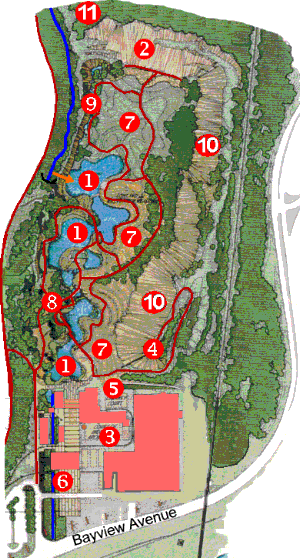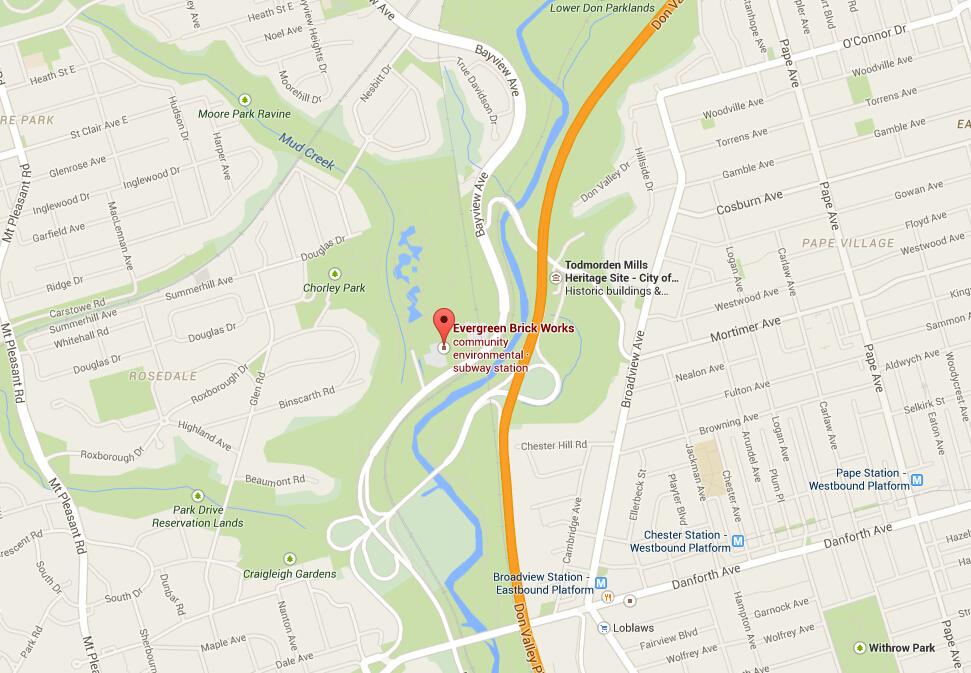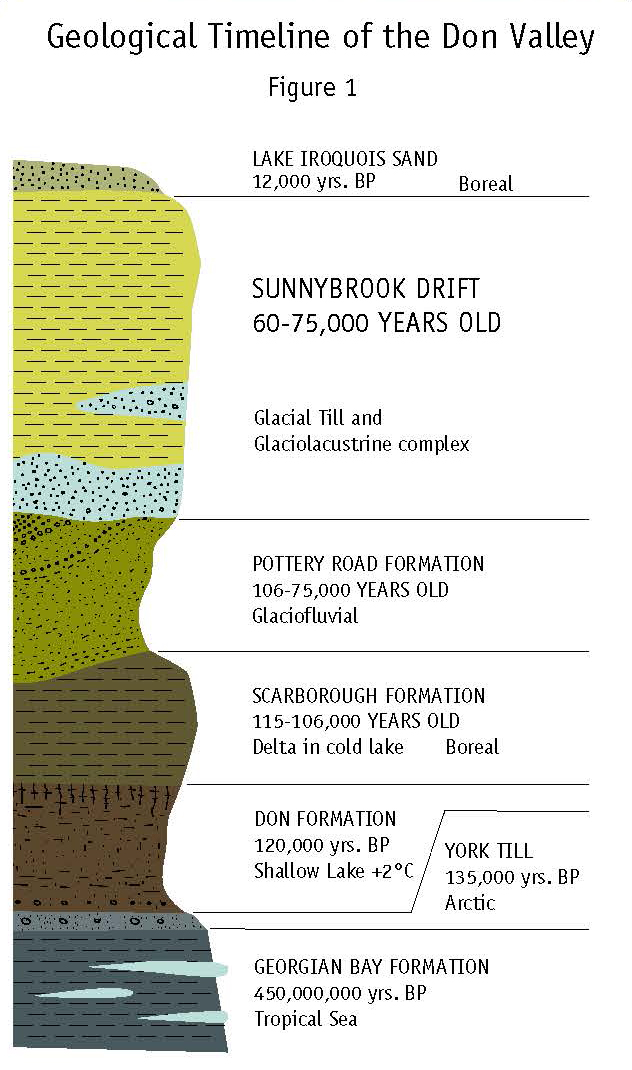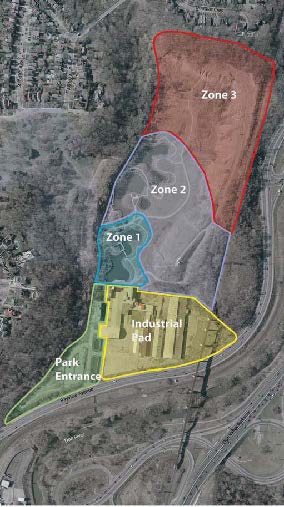Case Study Prepared by Chloe (Weiyi) Pei, Carleton University
Conservation of Geologic Heritage
Don Valley Bricks Work (Toronto, Ontario)
KEYWORDS
Area of Natural and Scientific Interest, Geological Significance, Stratum, Fossil, Natural rehabilitation, Evidence of Climate Change, Geotourism, Industrial Site
LESSONS LEARNED
In 2009, Evergreen Brick Works, the current occupant of Toronto’s historic Don Valley Brick Works, stood out from 610 candidates around the world, became one of the 10 finalists of the Geotourism Challenge – a competition sponsored by National Geographic and Ashoka Changemakers in search for good example of tourism that “sustain or enhance the geographic characteristics of the place[1]”. In its competition profile, Evergreen Brick Works presented itself as a hub for sustainable innovation and education with an emphasis on cultural heritage, natural rehabilitation and community involvement. All of the above are truthful descriptions of Evergreen expect for missing one significant characteristic of the site – its unique geologic heritage. The industrial activities during the brick making years in the 20th century had gradually removed the rocks and sand sediments of the site, revealed the stratum and fossils that carries valuable information about the geological history and climate pattern of the region. The site presents an unique scenario where the negative environmental impact of an invasive industrial activity gave rise to valuable resources for environmental study that might produce positive impact in the future. Therefore it’s not unreasonable to conclude that the geologic feature of the Don Valley Quarry is related closely with the sustainable theme celebrated by the Evergreen Brick Works. However, it’s rare to see both subjects discuss at the same time in the media since most of the spotlight was given to the adaptive and reuse project of the industrial remains. The site of Don Valley Brick Works, with its complexity, creates excellent opportunity for interdisciplinary discussion. A more holistic interpretation of the site with respect to all aspects of its heritage needs to be developed.
DESCRIPTION
Don Valley Bricks Work, 550 Bayview Ave, Toronto, ON M4W 3X8

Don Valley Brick Works Park Copyright of LostRivers
The Don Valley Brick Works is located in the Don River Valley north-east of downtown Toronto, flanked by the Mud Creek and the Don Valley Parkway. The site consists a total of 16.4 hectares of land. Historic factory buildings occupied 4.9 hectares at the south tip of the site, while the rest is the quarry pit.
Under the Master Plan developed jointly by the E.R.A. Architects and Evergreen, the industrial remains became a multi-program center with space dedicated to exhibition, art, food and recreation[2]. The quarry had turned into a garden through natural rehabilitation, reintroduced local species back to the land. The garden features natural filtration ponds (1), wildflower meadow (7), Carolinian Woodland community (8) and deciduous woodland slope (11), all linked by trails. The perimeter of the site is accentuated by the 80-ft high slope at the north (2) and west (10) end.
The site of Don Valley Brick Works has been studied extensively for architectural adapt and reuse as well as natural rehabilitation. Hence this case study will be focused primarily on the geologic heritage – how is it protected and presented.
TIMELINE
The following section presents the timeline of Don Valley Bricks Work from three aspects in order to provide a holistic understanding of the evolution of the site.
Industrial Timeline
- 1882 – William Taylor investigated the site in preparation of the establishment of the brickworks
- 1889 – Small scale brick-making operation established by the Taylor Brothers
- 1891 – Full scale brickmaking operation began
- 1901 – Factory sold to Robert Davies
- 1980s – Brick production ceased due to quarry exhaustion
- 1984 – Brick Works purchased by Torvalley Associated Ltd. Toryvalley began filling in the quarry and leased the land to Brampton Brick until the final closure of the Brick Works.
- 1989 – Brick Works closed permanently
Site Redevelopment Timeline [3]
- 1989 – Toronto Region Conservation Authorities expropriated the land from Torvalley
- 1990 – First Master Plan created by Hough Stanbury Woodland Limited
- 1993 – Master Plan drafted by the Toronto and Region Conservation Authority
- 1995 – Final version for the 1993 draft; conservation of the site began
- 1997 – Detailed planting plans for first phase of development created by Garden Club of Toronto
- 1998 – Mud Creek Reconnection Project initiated by Schollen and Company Inc.
- 2004 – Phase Two Park Development Planned by Hough Woodland Naylor Dance Leister Limited
- 2006 – Jointed Master Plan created by Evergreen Architect Alliance and ERA Architects
- 2007 – Don Valley Brick Works Park: Natural Heritage Impact Study and Enhancement Strategy prepared by the collaboration of The Planning Partnership, Michael Hough and AMEC Earth & Environmental
- 2008 – Evergreen Brick Works: Natural Heritage Impact Study, Tree Preservation Plan and Ravine Stewardship Plan drafted by Dougan & Associates
- 2009 – Mud Creek Regeneration Concept presented by Schollen and Company Inc.
- 2010 – Weston Quarry Garden entrance feature designed by The Planning Partnership
- 2010 – Recreational access between Brick Works and Beltline Trail proposed by Scott Torrance Landscape Architect Inc.
STAKEHOLDERS
- Ownership
- City of Toronto
- Toronto and Region Conservation Authority (TRCA)
- Occupant
- Evergreen
- Management
- Originally managed by TRCA
- Currently managed jointly by City of Toronto’s Parks and Recreation Department and Evergreen
- Community of Interest
- Friends of the Valley
NATURAL-CULTURAL HERITAGE
According to its Statement of Significant, the Don Valley Brick Works is significant “for its association with the historical development of the Don Valley and the history of brick making in Toronto and Ontario.[4]”As the longest operating brick work in the province, bricks produced by the Don Valley Brick Works built many significant buildings in Toronto, particular after the great fire of 1904, including Massey Hall and Casa Loma[5]. The industrial remains of Don Valley Brick Works were formally designated by Ontario Heritage Trust in the year of 2008.
The natural heritage of the site is strongly associate with the industrial usage of the land. According to Jennifer Foster of York University, “As clay for the bricks was gradually removed over the century-long excavation, a stunning geological and fossil record was revealed that provides a rare record of a sequence of climatic changes.[6]” The geologic significant of the Don Valley Quarry is academically recognized and internationally acclaimed in the field of geology. The North Slope is one of the few sites around the world where a complete set of stratum can be easily accessed and studied. The West Slope is rich in fossil deposit. Geologist A.P. Coleman was among the first group of scholars who shown interest to the site. Through the many works of Coleman, and others, the Brick Works sections were well studied for over 40 years since the end of the 19th century [7]. In 1983, Don The Don Valley Brick Works was designated by the Ontario Ministry of Natural Resource as a Area of Natural and Scientific Interest.
SUSTAINABILITY
The sustainable theme of the geologic heritage of the Don Valley Brick Works is best manifested through the education programs developed and offered by Evergreen[8], City of Toronto[9] as well as other private parties[10]. The tours were carried out through the spring and summer time of the years, leaded by local historians and geologists. A wide selection of topics were discussed, ranging from basic geology to brick making process. The site visit allowed the participants to have first hand contact with the material of study, provided an easy introduction to some abstruse subjects such as earth history and climate change. Those educational programs ensure the longevity of the geologic heritage through active promotion of its value as well as interdisciplinary discussion.
However, tours can have possible negative impact over the integrity of the geologic heritage. The correlation between human activities and the erosion of slope had been made by Evergreen in its 2006 Master Plan, then AMEC Earth & Environmental’s on Valley Brick Works Park: Natural Heritage Impact Study and Enhancement Strategy in 2007. In order to maximize the positive impact of the educational programs and achieve true sustainability, proper assessment is necessary for evaluate the impact of tourism over the geology heritage. Mitigation strategies such as fencing, designed route and proper signage should be implemented where necessary to restrict access in the area of protection, at the same time provide better control of human activities on site.
MEASUREMENT
The Don Valley Brick Works was designed by the Ontario Ministry of Natural Resource (MNR) as a Area of Natural and Scientific Interest (ANSI). ANSI is an Ontario designation defined as “areas of land and water containing natural landscape or features that have been identified as having life science or earth science values related to protection, scientific study or education.“[11] A site can be designed as either life science ANSI or earth science ANSI. The former showcases representative biodiversity and natural landscape of the province, while the latter contains significant geologic features such as bedrock, fossils and landforms. MNR uses the following five criteria to evaluate a site’s eligibility for the ANSI designation[12]:
- Representation – of geological themes or landform-vegetation features of an ecodistrict.
- Condition – an assessment of the degree of human-induced disturbances
- Diversity – the number of high quality, representative features that exist within a site are assessed
- Other ecological considerations – ecological and hydrological functions, connectivity, size, shape, proximity to other important areas, etc.
- Special features – such as populations of species at risk, special habitats, unusual geological or life science features and educational or scientific value.
Once the site is designed, it is entitled to the protection stated in the Natural Heritage Policies of the Provincial Policy Statement. A buffer zone of 120m for life science ANSIs and 50m for earth science ANSIs is recommended to ensure the minimal disturbance to the protected area[13]. Development and site alternation is forbidden in both ANSIs and its buffer zone, unless the proposal is proven to have no negative impact on the nature features or the ecological functions of the site. The policy also introduced fencing as a mitigation tool for controlling public access [14].
In the Master Plan of 2006, recommendations were made to TRCA by Evergreen in respect to the site’s ANSI designation. Five zones were established with different level of accessibility. The Parking entrance and the Industrial Pad remained most accessible throughout the site while Zone 3 was the most restricted and should not be accessed by visitors. Certain activities such as biking and off-leash dog walking should be eliminated due to their high ecological impact. The Natural Heritage Impact Study and Enhancement Strategy completed in 2007 confirmed the correlation between human activities and slope erosion.
In reality, little was done according to the recommendation. The park continue to function primarily as an dog walking park [15]. Without proper signage and fencing, both north and west slopes can be easy access from above and below, attract curious visitors who wish to explore the “off trail route” as well as local mountain hikers.
- [1] As defined by the Geotourism Challenge 2009
- [2] Function plan can be access from Evergreen’s website
- [3] The timeline is largely based on the List of Landscape Consultants of Don Valley Brick Works complied by Jennifer Manhoney
- [4] The completed Statement of Significance can be access athttp://historicplaces.ca/en/rep-reg/place-lieu.aspx?id=15361&pid=0
- [5] Evergreen Brick Works. (2014). History.
- [6]Foster, J. (2005). p.339
- [7] Kelly, R. I., Barnett, P. J., Delorme, R. J., Ontario. Ministry of Northern Development and Mines, & Ontario Geological Survey. (1987). p 6
- [8] Self Guided Geology Tour
- [9] Don Valley Brick Work Park Spring/Summer Event 2014
- [10] Fossil Finding Tour provided by Royal Ontario Museum
- [11] Ministry of Natural Resources. (2011). p.1
- [12] Ministry of Natural Resources. (2011). p.2
- [13] Ministry of Natural Resources.(2010). p.93
- [14] Ministry of Natural Resources.(2010). p.132
- [15] Foster, J. (2005). p.343
SOURCES
JOURNAL ARTICLES
- Côté, Anna. (2013). From Brown to Green? The Planning and Implementation of the Don Valley Brick Works’ Restoration. Retrieved December 2, 2014, from http://fes.yorku.ca/files/Anna%20Cote%20-%20FINAL%20MRP.pdf
- Foster, J. (2005). Restoration of the Don Valley Brick Works: Whose Restoration? Whose Space? Journal of Urban Design,10(3), 331-351.
- Miranda, B. (2010). City Building, Brick by Brick: Transforming a Heritage Industrial Site. Ground: Landscape Architect Quarterly, 11(12). Retrieved November 20, 2014, from http://www.oala.ca/wp-content/uploads/2011/06/GROUND-11-Restoration-Rehabilitation-Repurposing.pdf
- Kelly, R. I., Barnett, P. J., Delorme, R. J., Ontario. Ministry of Northern Development and Mines, & Ontario Geological Survey. (1987). An annotated bibliography of the quaternary geology and history for the don valley brickworks. (No. 135). Toronto: Ontario Ministry of Northern Development and Mines.
POLICY DOCUMENTS
- City of Toronto (2006, June 16). Staff Report. Retrieved Octorber 31, 2014, from http://www.toronto.ca/legdocs/2006/agendas/committees/adm/adm060704/it031.pdf
- ICOMOS (2011). Joint ICOMOS-TICCIH Principles for the Conservation of Industrial Heritage Sites, Structures, Areas and Landscapes. Retrieved November 20, 2014, from http://www.icomos.org/Paris2011/GA2011_ICOMOS_TICCIH_joint_principles_EN_FR_final_20120110.pdf
- Ministry of Natural Resources. (2010). Natural Heritage Reference Manual for Natural Heritage Policies of the Povincial Policy Statement, 2005. (2nd ed.). Retrieved December 9, 2014, from http://docs.files.ontario.ca/documents/3270/natural-heritage-reference-manual-for-natural.pdf
- Ministry of Natural Resources. (2011).Identification and Confirmation Procedure for Areas
of Natural and Scientific Interest. Retrieved December 9, 2014, from http://www.ontarioparks.com/english/planning_pdf/ansi/ansi_procedure.pdf
WEBSITES
- Evergreen Brick Works. (2014). History. Retrieved December 2, 2014, from http://www.evergreen.ca/get-involved/evergreen-brick-works/about/history/
- Historic Places (2008, January 11). Don Valley Brick Works. Retrieved October 30, 2014, from http://historicplaces.ca/en/rep-reg/place-lieu.aspx?id=15361&pid=0
- Lost Rivers (2013). Don Valley Brick Work Parks .Retrieved October 30, 2014, from http://www.lostrivers.ca/BrickWorksPark.htm
- Michael Dean, R. The Canadian Encyclopedia. (2012). Evergreen Brick Works . Retrieved November 3, 2014, from http://www.thecanadianencyclopedia.ca/en/article/evergreen-brick-works/
- Riddle, C. (2013, March 5). What the Don Valley Brick Works Might Have Been. Retrieved October 31, 2014, from http://torontoist.com/2013/03/what-the-don-valley-brick-works-might-have-been/


